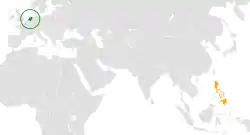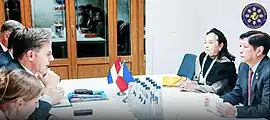 | |
Netherlands |
Philippines |
|---|---|
The Netherlands–Philippines relations refers to the bilateral relations between the Netherlands and the Philippines.
History

Early relations between the Netherlands and the Philippines can be traced as early as the 17th century when a Dutch warship raided Spanish outpost in the Philippines, until the independence of the Netherlands was acknowledged in the mid-17th century. Underground trade between the Dutch East Indies and the Philippines was mostly tolerated until the formalization of economic trade in 1866, with the establishment of a Dutch honorary consulate in Manila, van Polanen Petel as the first honorary consul.[1]
The Philippines established its embassy in the Hague in May 1960, with the first Philippine ambassador presenting credentials to Queen Juliana.[2]
Economic relations
As of 2014, the Netherlands is the 3rd biggest investor in the Philippines and the 10th largest export partner of the Southeast Asian country.[2]
Security ties
The Dutch Foreign Ministry stated in their website that the only irritant in the relations between the Netherlands and the Philippines is the presence of what they called the said Philippine Communist leadership in Utrecht.[3]
Resident diplomatic missions
 Embassy of the Philippines in The Hague
Embassy of the Philippines in The Hague
See also
References
- ↑ "A Primer on the Philippine-European Relations and the Partnership and Cooperation Agreement between the Republic of the Philippines and the European Union". IDEALS Inc. Retrieved 27 December 2014.
- 1 2 Ledda, Jaime Victor. "A Review of Philippines – Netherlands Relations". Diplomat Magazine. Retrieved 27 December 2014.
- ↑ Remollino, Alexander Martin (9 September 2007). "Dutch-Philippine Relations: The Ties That Bind". Bulatlat. III (31). Retrieved 27 December 2014.
External links
 Media related to Relations of the Netherlands and the Philippines at Wikimedia Commons
Media related to Relations of the Netherlands and the Philippines at Wikimedia Commons

